Residual Fire Resistance Testing of Basalt- and Hybrid-FRP Reinforced Concrete Beams
Abstract
:1. Introduction
2. Novelty and Significance of the Work
3. Materials and Experimental Program
3.1. Decription of Experimental Program
- (1)
- To simulate realistic situations, i.e., cracks appearing, beams from set 1.1 and set 1.2 were preliminary loaded up to 50% of their ultimate strength capacity and then unloaded;
- (2)
- The middle section of unloaded, cracked beams was placed inside a furnace so that the temperature could be applied from below and from the sides;
- (3)
- (4)
- The beams went through a cooling phase for approximately 24 h;
- (5)
- After the cooling phase, the strength of the beams was determined by the four-point flexural test.
3.2. Materials
3.2.1. Concrete
3.2.2. Reinforcement
4. Test Setup and Specimen Dimensions
5. Results and Discussion
5.1. Destruction of Samples
5.2. FRP Bars after Applying Elevated Temperatures
5.3. Temperature Distribution
5.4. Deflections during Heating and Cooling Phases
5.5. Residual Strength
6. Conclusions
- The BFRP-RC samples in the present study did not survive for two hours at elevated temperatures, unlike beams from a previous study, which could withstand higher temperatures for approximately one hour;
- The strength reduction in HFRP-RC beams after one hour was approximately 40%, while in the present study the strength capacity was reduced by approximately 70%. The above facts may suggest the importance of the heating time parameter;
- The beams exposed to elevated temperatures were destroyed due to reinforcement failure, whereas the reference beams were destroyed by concrete crushing. This indicates that temperature influences bar strength in a substantial manner;
- Deflections in BFRP-RC beams were approximately two times greater than those measured for HFRP-RC beams. This can be explained by the presence of carbon fibers in the HFRP bars, which has the effect of “prestressing” HFRP-RC beams, which can be observed during heating and cooling.
Funding
Institutional Review Board Statement
Informed Consent Statement
Data Availability Statement
Acknowledgments
Conflicts of Interest
Abbreviations
| FRP | Fiber-Reinforced Polymers |
| BFRP | Basalt-Fiber-Reinforced Polymers |
| HFRP (HC/BFRP) | Hybrid-Fiber-Reinforced Polymers (Hybrid Carbon/Basalt-Fiber-Reinforced Polymers) |
| GFRP | Glass-Fiber-Reinforced Polymers |
| CFRP | Carbon-Fiber-Reinforced Polymers |
| nHFRP | Nano-Hybrid-Fiber-Reinforced Polymers |
| RC | Reinforced Concrete |
| FRP-RC | Fiber-Reinforced Polymer Reinforced Concrete |
| BFRP-RC | Basalt-Fiber-Reinforced Polymer Reinforced Concrete |
| HFRP-RC | Hybrid Fiber-Reinforced Polymers Reinforced Concrete |
| DMA | Dynamic mechanical analysis |
| Tg | Glass transition temperature |
| Td | Decomposition temperature |
| B2Ø14 | The beams reinforced with 2 bars (BFRP type) of the diameter of 14 mm |
| H2Ø14 | The beams reinforced with 2 bars (HFRP type) of the diameter of 14 mm |
| TIso | Temperature obtained in accordance with a standard heating curve ISO-834 |
References
- Balendran, R.V.; Rana, T.M.; Maqsood, T.; Tang, W.C. Application of FRP bars as reinforcement in civil engineering structures. Struct. Surv. 2002, 20, 62–72. [Google Scholar] [CrossRef]
- Kashwani, G.A.; Al-Tamimi, A.K. Evaluation of FRP bars performance under high temperature. Phys. Procedia 2014, 55, 296–300. [Google Scholar] [CrossRef] [Green Version]
- Yehia, S.; Kashwani, G. Performance of Structures Exposed to Extreme High Temperature—An Overview. Open J. Civ. Eng. 2013, 3, 154–161. [Google Scholar] [CrossRef] [Green Version]
- Hollaway, L.C. Polymer Composites for Civil and Structural Engineering; Blackie Academic and Professional: Glasgow, UK, 1993; pp. 12–62. [Google Scholar]
- Garbacz, A.; Radomski, W.A.; Mossakowski, P. Alternatywne zbrojenie betonu kompozytami FRP—Zagadnienie kompatybilności (in English—Alternative reinforcement of concrete using FRP composites—compatibility issues). Mosty 2015, 73, 42–45. [Google Scholar]
- Clyne, T.W.; Hull, D. An Introduction to Composite Materials, 3rd ed.; Cambridge University Press: Cambridge, UK, 2019; p. 345. [Google Scholar]
- Ogrodowska, K.; Łuszcz, K.; Garbacz, A. Nanomodification, Hybridization and Temperature Impact on Shear Strength of Basalt Fiber-Reinforced Polymer Bars. Polymers 2021, 13, 2585. [Google Scholar] [CrossRef]
- Protchenko, K.; Włodarczyk, M.; Szmigiera, E.D. Investigation of Behavior of Reinforced Concrete Elements Strengthened with FRP. Procedia Eng. 2015, 111, 679–686. [Google Scholar] [CrossRef] [Green Version]
- Elgabbas, F.; Ahmed, E.; Benmokrane, B. Physical and Mechanical Characteristics of New Basalt-FRP Bars for Reinforcing Concrete Structures. J. Constr. Build. Mater. 2015, 95, 623–635. [Google Scholar] [CrossRef]
- Elgabbas, F.; Ahmed, E.; Benmokrane, B. Flexural behaviour and bond-dependent coefficient of basalt FRP bars in concrete beams. In Proceedings of the CSCE 2016, London, ON, Canada, 1–4 June 2016. [Google Scholar]
- Wei, B.; Cao, H.; Song, S. Environmental Resistance and Mechanical Performance of Basalt and Glass Fibers. J. Mater. Sci. Eng. Part A 2010, 527, 4708–4715. [Google Scholar] [CrossRef]
- Szmigiera, E.; Urbański, M.; Protchenko, K. Strength Performance of Concrete Beams Reinforced with BFRP Bars. In International Congress on Polymers in Concrete (ICPIC 2018); Springer: Cham, Switzerland, 2018; pp. 667–674. [Google Scholar]
- Garbacz, A.; Urbański, M.; Łapko, A. BFRP bars as an alternative reinforcement of concrete structures—Compatibility and adhesion issues. Adv. Mater. Res. 2015, 1129, 233–241. [Google Scholar] [CrossRef]
- Wang, X.; Chen, Z.; Ding, L.; Shi, Y.; Zhu, Z.; Wu, Z. Long-term flexural behavior of concrete beams with hybrid FRP and steel reinforcements in simulated marine environment. Structures 2021, 33, 4556–4567. [Google Scholar] [CrossRef]
- Xian, G.; Guo, R.; Li, C. Combined effects of sustained bending loading, water immersion and fiber hybrid mode on the mechanical properties of carbon/glass fiber reinforced polymer composite. Compos. Struct. 2022, 281, 115060. [Google Scholar] [CrossRef]
- Ashrafi, H.; Bazli, M.; Najafabadi, E.P.; Vatani Oskouei, A. The effect of mechanical and thermal properties of FRP bars on their tensile performance under elevated temperatures. Constr. Build. Mater. 2017, 157, 1001–1010. [Google Scholar] [CrossRef]
- Kowalski, R.; Głowacki, M.J.; Abramowicz, M. Premature destruction of two-span RC beams exposed to high temperature caused by a redistribution of shear forces. J. Civ. Eng. Manag. 2016, 22, 431–439. [Google Scholar] [CrossRef] [Green Version]
- Kowalski, R.; Głowacki, M.J.; Wróblewska, J. Thermal Bowing of Reinforced Concrete Elements Exposed to Non-Uniform Heating. Arch. Civ. Eng. 2018, 64, 247–264. [Google Scholar] [CrossRef] [Green Version]
- CAN/CSA S806-12; Design and Construction of Building Structures with Fibre-Reinforced Polymers. Canadian Standards Association: Mississauga, ON, Canada, 2012; p. 206.
- ACI. Guide for the Design and Construction of Concrete Reinforced with FRP Bars; ACI 440.1R-15; American Concrete Institute: Farmington Hills, MI, USA, 2015. [Google Scholar]
- Protchenko, K.; Szmigiera, E.; Urbański, M.; Garbacz, A.; Narloch, P.; Leśniak, P. State-of-the-Art on Fire Resistance Aspects of FRP Reinforcing Bars. IOP Conf. Ser. Mater. Sci. Eng. 2019, 661, 012081. [Google Scholar] [CrossRef]
- Robert, M.; Benmokrane, B. Behavior of GFRP Reinforcing Bars Subjected to Extreme Temperatures. J. Compos. Constr. 2010, 14, 353–360. [Google Scholar] [CrossRef]
- Ellis, D.; Tabatabai, H.; Nabizadeh, A. Residual Tensile Strength and Bond Properties of GFRP Bars after Exposure to Elevated Temperatures. Materials 2018, 11, 346. [Google Scholar] [CrossRef] [Green Version]
- Wang, X.L.; Zha, X.X. Experimental Research on Mechanical Behavior of GFRP Bars under High Temperature. Appl. Mech. Mater. 2011, 71–78, 3591–3594. [Google Scholar] [CrossRef]
- Hamad, R.J.; Johari, M.M.; Haddad, R.H. Mechanical properties and bond characteristics of different fiber reinforced polymer rebars at elevated temperatures. Constr. Build Mater. 2017, 142, 521–535. [Google Scholar] [CrossRef]
- Lapko, A.; Urbański, M. Experimental and theoretical analysis of deflections of concrete beams reinforced with basalt rebar. Arch. Civ. Mech. Eng. 2015, 15, 223–230. [Google Scholar] [CrossRef]
- Weber, A. Fire-resistance tests on composite rebars. In Proceedings of the CICE2008, Zurich, Switzerland, 22 July 2008. [Google Scholar]
- Kodur, V.K.R.; Bisby, L.A.; Foo, S. Thermal behaviour of fire-exposed concrete slabs reinforced with fibre reinforced polymer bars. ACI Struct. J. 2005, 102, 799–808. [Google Scholar]
- Abbasi, A.; Hogg, P. Temperature and environmental effects on glass fibre rebar: Modulus, strength and interfacial bond strength with concrete. Compos. Part B Eng. 2005, 36, 394–404. [Google Scholar] [CrossRef]
- Saafi, M. Effect of fire on FRP reinforced concrete members. J. Compos. Struct. 2002, 58, 11–20. [Google Scholar] [CrossRef]
- Bai, Y.; Keller, T. Fire performance of water-cooled GFRP columns. II: Postfire investigation. J. Compos. Constr. 2011, 15, 413–421. [Google Scholar] [CrossRef]
- Alsalihi, M.A.J. Mechanical Properties of Glass Fiber Reinforced Polymer Bars after Exposure to Elevated Temperatures. Ph.D. Thesis, The University of Wisconsin, Milwaukee, WI, USA, 2014. Available online: https://dc.uwm.edu/etd/654 (accessed on 14 February 2022).
- Vieille, B.; Coppalle, A.; Carpier, Y.; Maaroufi, M.A.; Barbe, F. In fluence of matrix nature on the post-fire mechanical behaviour of notched polymer-based composite structures for high temperature applications. Compos. Part B Eng. 2016, 100, 114–124. [Google Scholar] [CrossRef]
- Maaroufi, M.A.; Carpier, Y.; Vieille, B.; Gilles, L.; Coppalle, A.; Barbe, F. Post-fire compressive behaviour of carbon fibers woven-ply Polyphenylene Sulfide laminates for aeronautical applications. Compos. Part B Eng. 2017, 119, 101–113. [Google Scholar] [CrossRef]
- Bai, Y.; Keller, T.; Vallee, T. Modeling of thermo-physical properties and thermal responses for FRP composites in fire. In Proceedings of the Asia-Pacific Conference on FRP in Structures; University of Hong Kong: Hong Kong, China, 2007; pp. 645–650. [Google Scholar] [CrossRef]
- Nanni, A.; Faza, S. Design and Construction of Concrete Reinforced with FRP Bars: An Emerging Technology. Concr. Int. 2002, 24, 53–58. [Google Scholar]
- Protchenko, K.; Szmigiera, E. Post-Fire Characteristics of Concrete Beams Reinforced with Hybrid FRP Bars. Materials 2020, 13, 1248. [Google Scholar] [CrossRef] [Green Version]
- EN 1363-1:2012; Fire Resistance Tests. General Requirements. British Standards Institution: London, UK, 2012.
- ISO 834-1; Fire Resistance Tests—Elements of Buildings Construction, Part-1 General Requirements. International Organization for Standardization: Geneva, Switzerland, 1999.
- PN-EN 12390-3:2019-07. Testing Hardened Concrete (PL: Część 3: Wytrzymałość na ściskanie próbek do badan) (EN: Part 3: Compressive Strength of Test Specimens), CEN/TC 104. 2019. Available online: https://sklep.pkn.pl/pn-en-12390-3-2019-07p.html (accessed on 3 January 2022).
- Protchenko, K.; Szmigiera, E.D.; Urbański, M.; Garbacz, A. Development of Innovative HFRP Bars. MATEC Web Conf. 2018, 196, 04087. [Google Scholar] [CrossRef]
- Garbacz, A.; Szmigiera, E.D.; Protchenko, K.; Urbański, M. On Mechanical Characteristics of HFRP Bars with Various Types of Hybridization. In International Congress on Polymers in Concrete (ICPIC 2018); Springer: Cham, Switzerland, 2018; pp. 653–658. [Google Scholar]
- Szmigiera, E.; Protchenko, K.; Urbański, M.; Garbacz, A. Mechanical Properties of Hybrid FRP Bars and Nano-Hybrid FRP Bars. Arch. Civ. Eng. 2019, 65, 97–110. [Google Scholar] [CrossRef] [Green Version]
- Protchenko, K.; Dobosz, J.; Urbański, M.; Garbacz, A. Wpływ substytucji włókien bazaltowych przez włókna węglowe na właściwości mechaniczne prętów B/CFRP (HFRP) (in English—Influence of the substitution of basalt fibres by carbon fibres on the mechanical behavior of B/CFRP (HFRP) bars). Czas. Inżynierii Lądowej Sr. I Archit. JCEEA 2016, 63, 149–156. [Google Scholar]
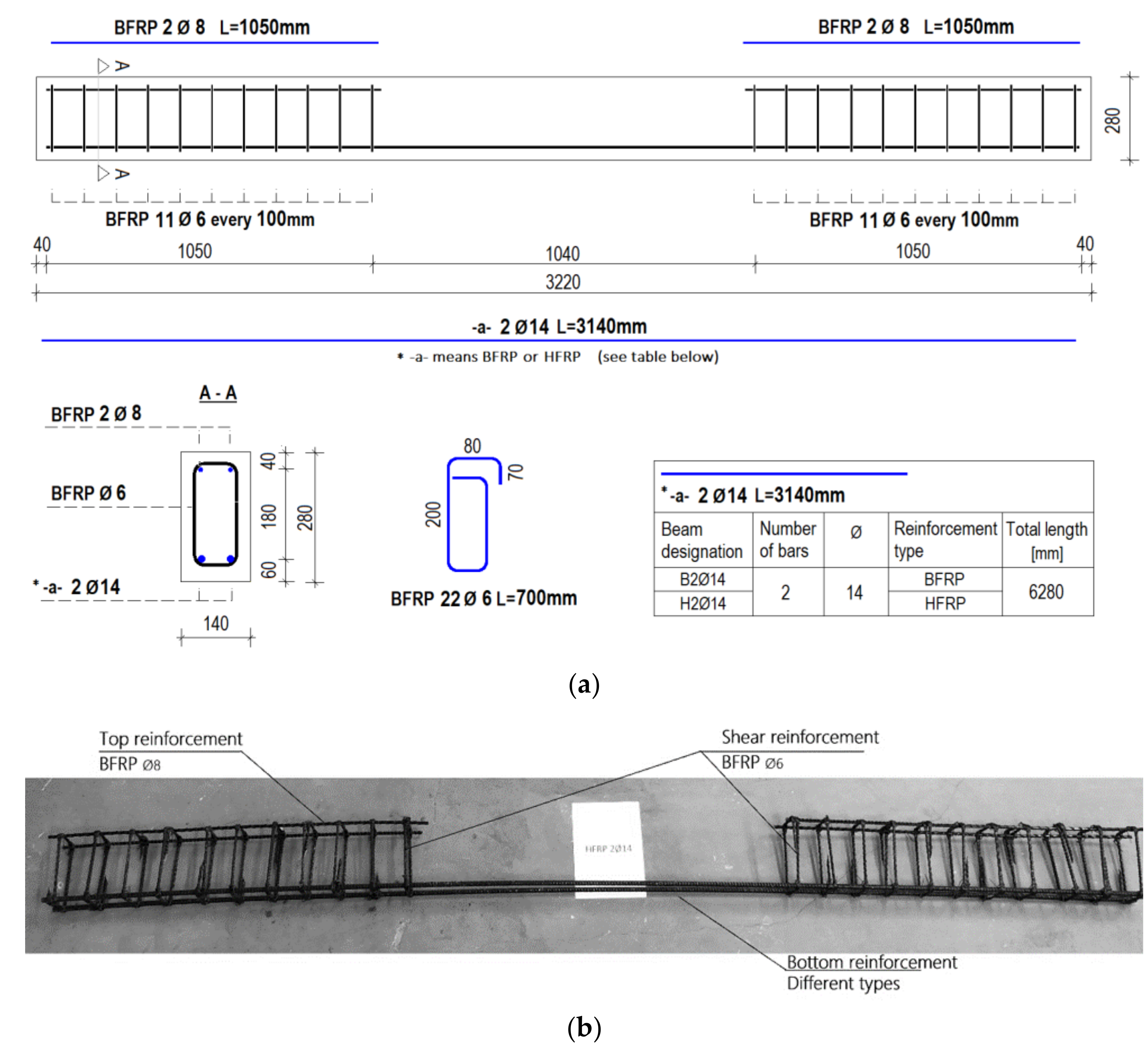
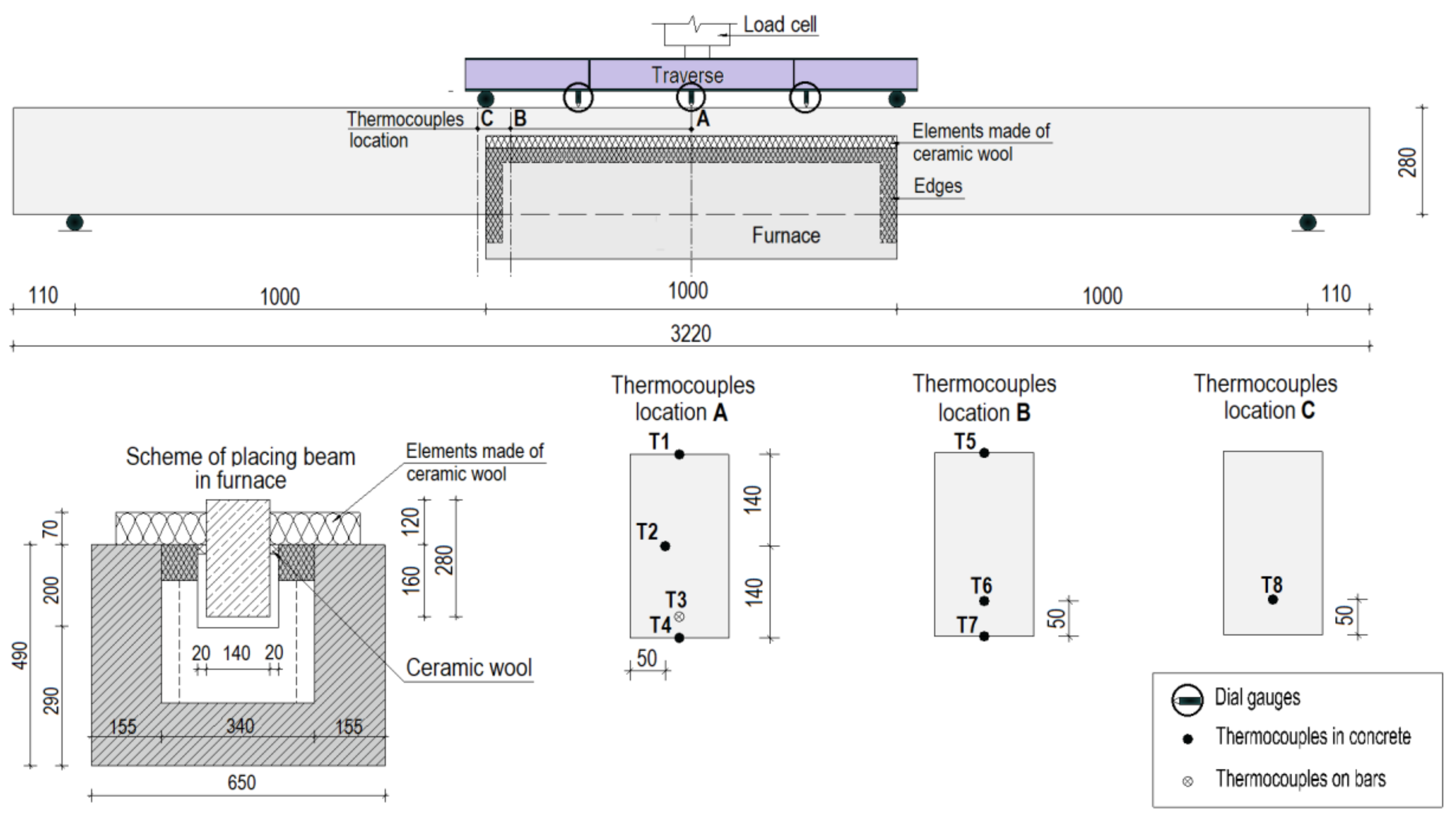
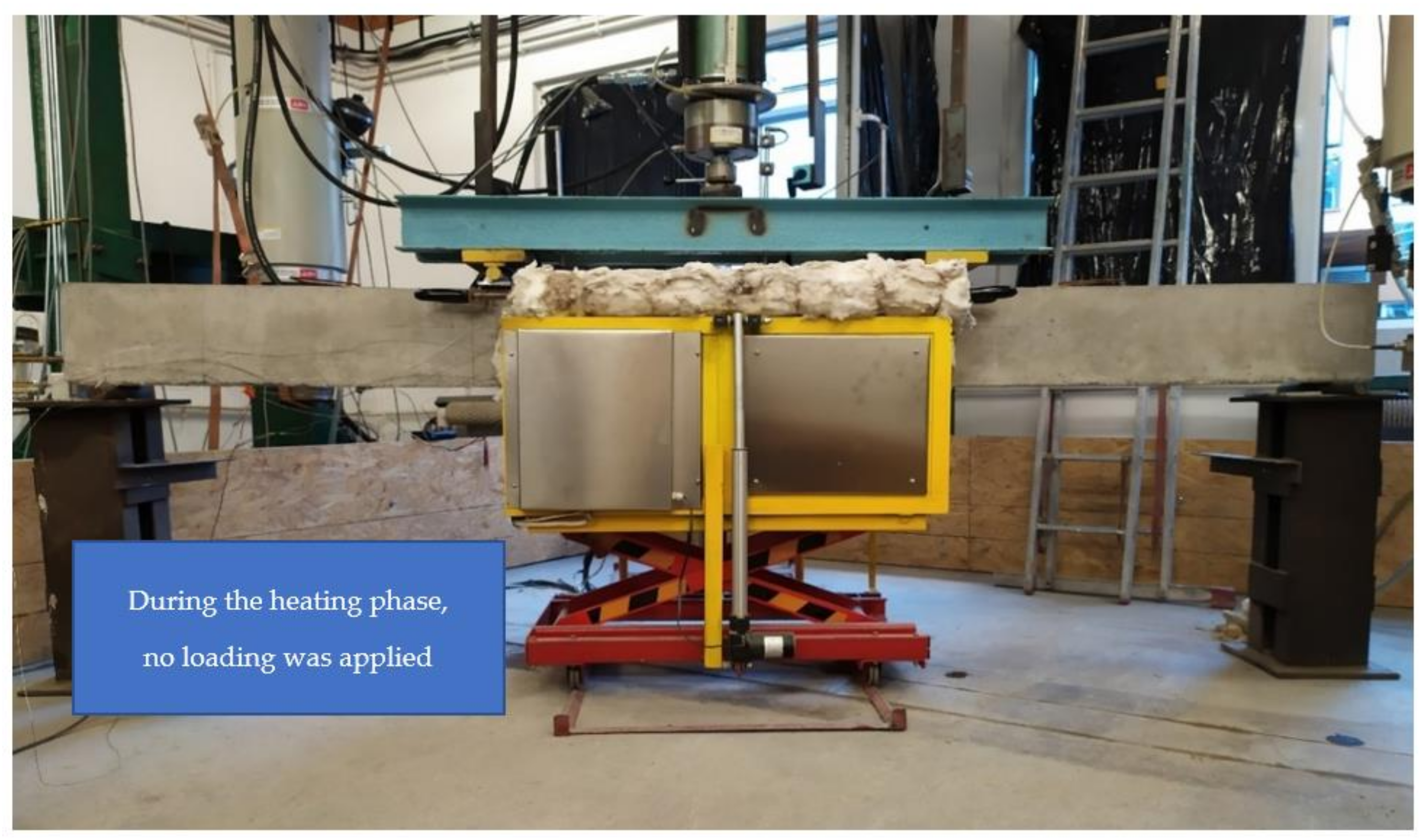
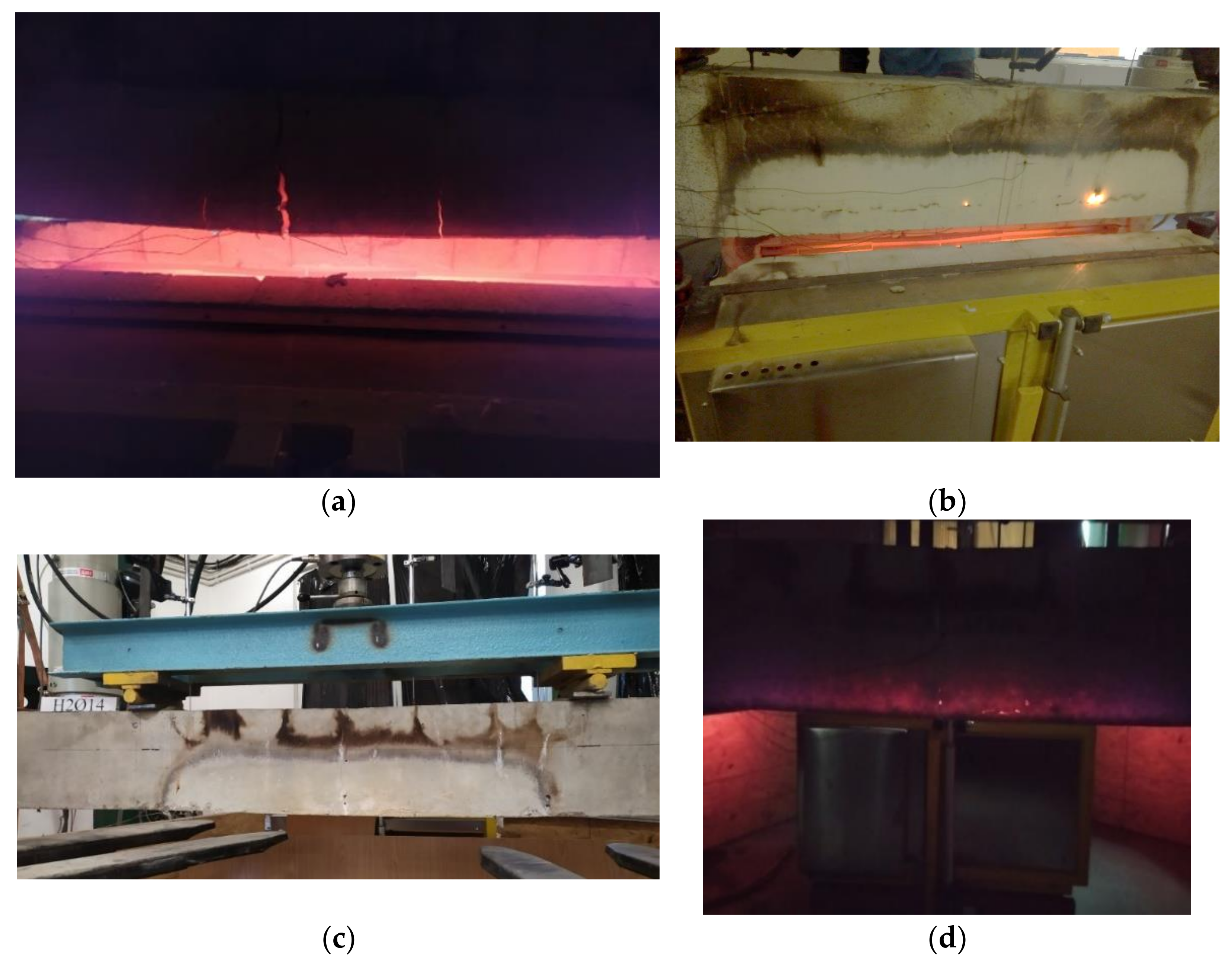

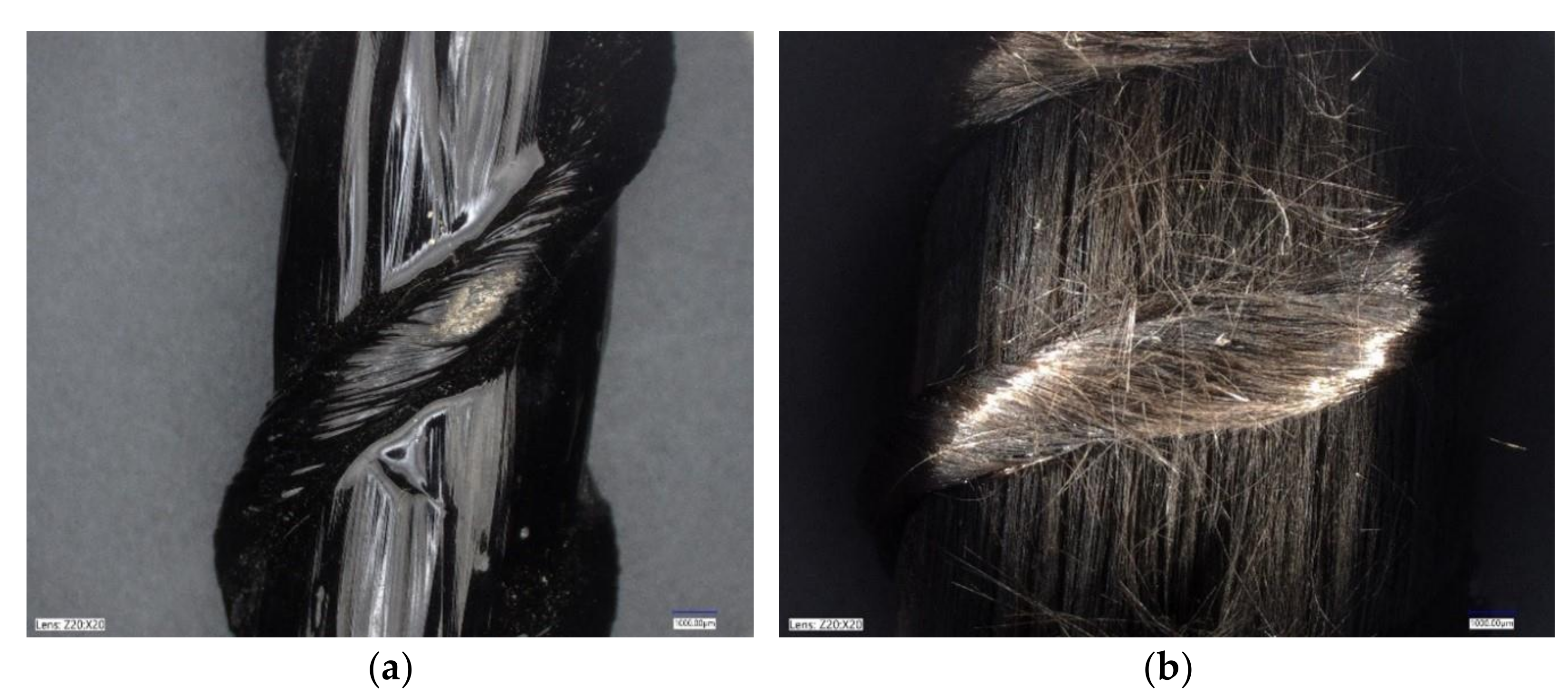
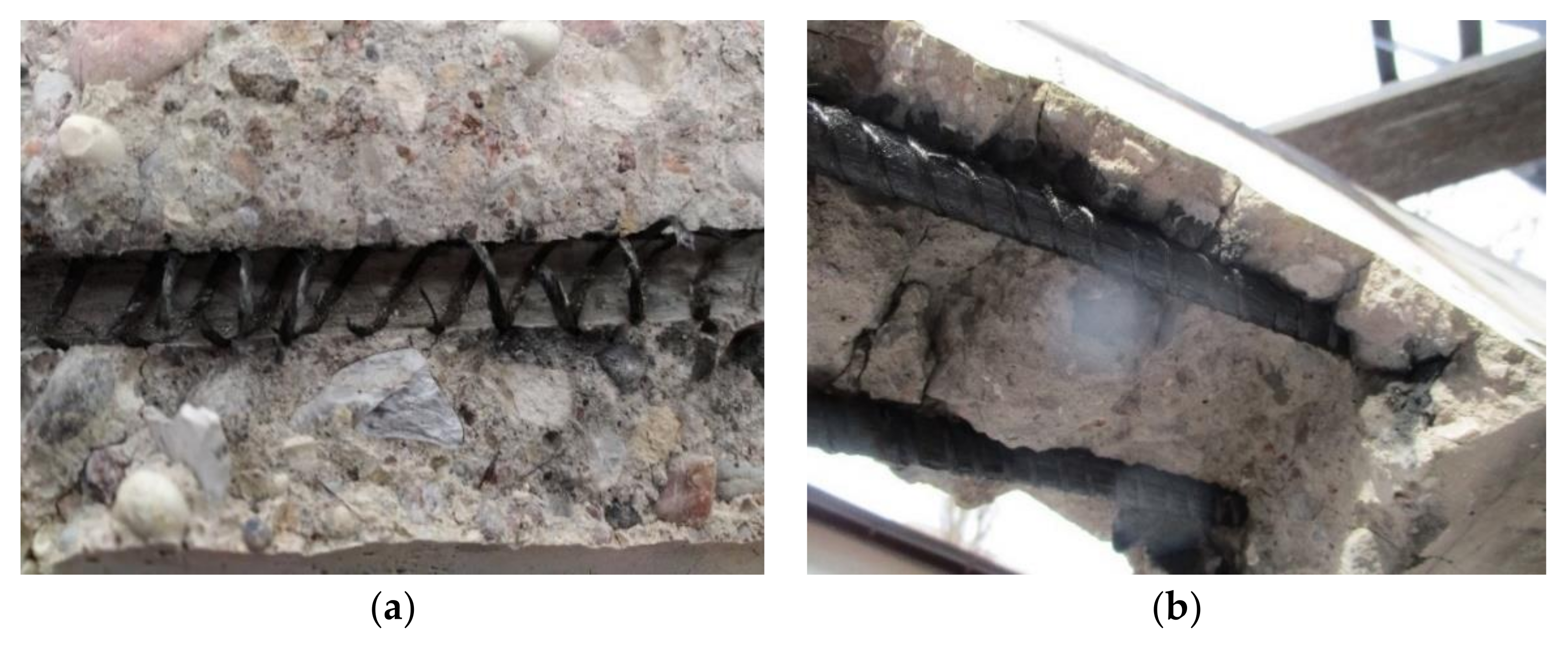
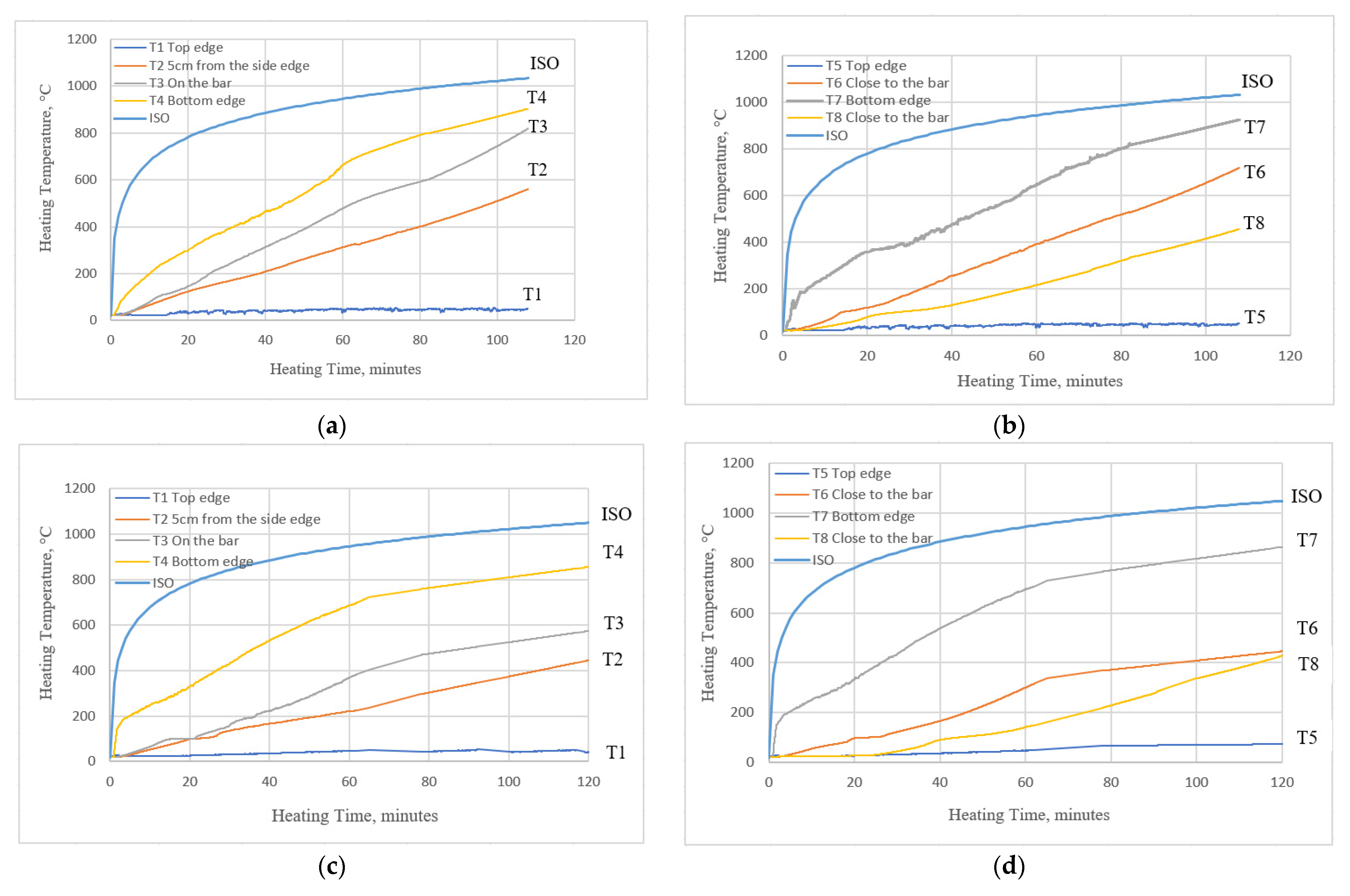
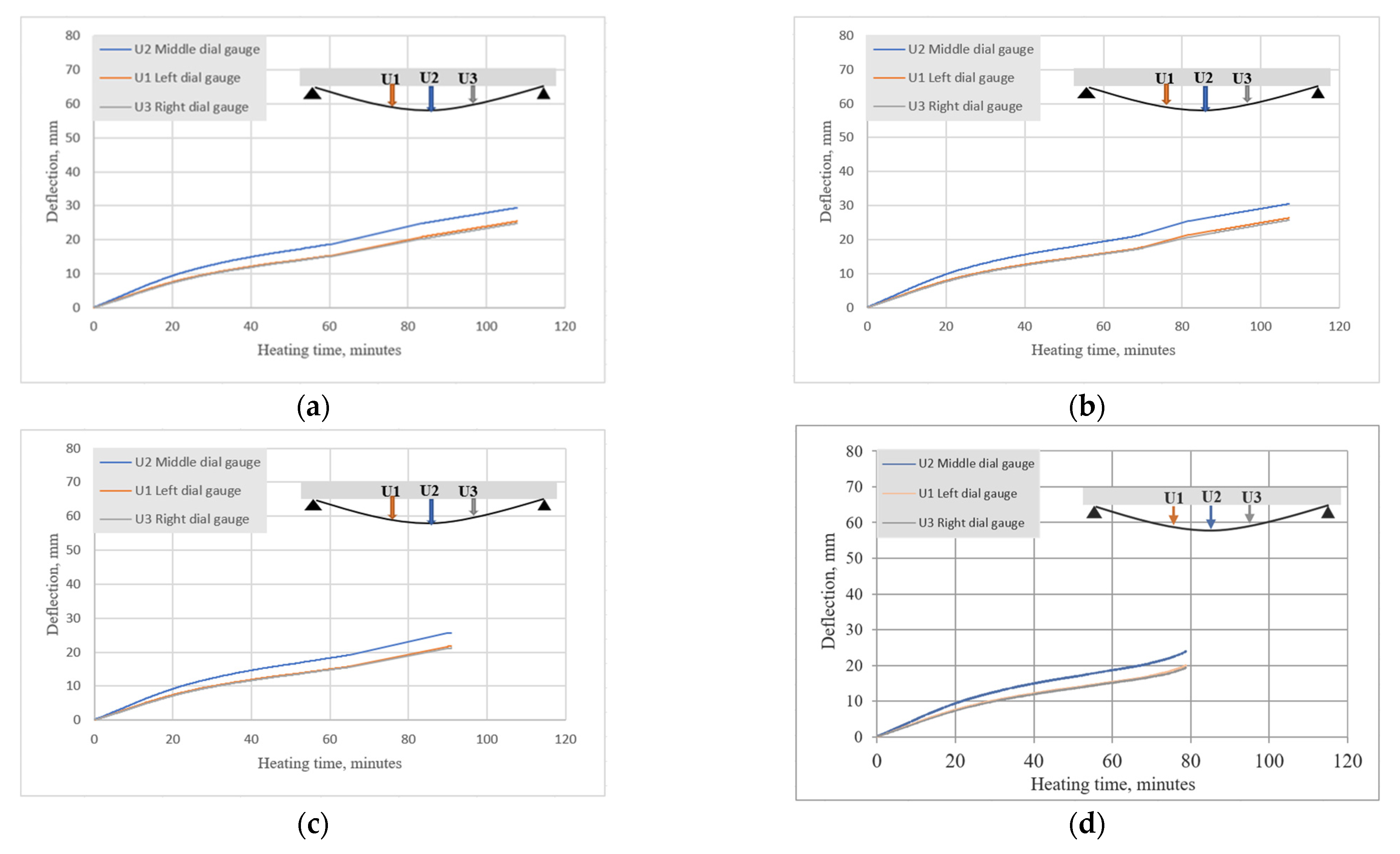

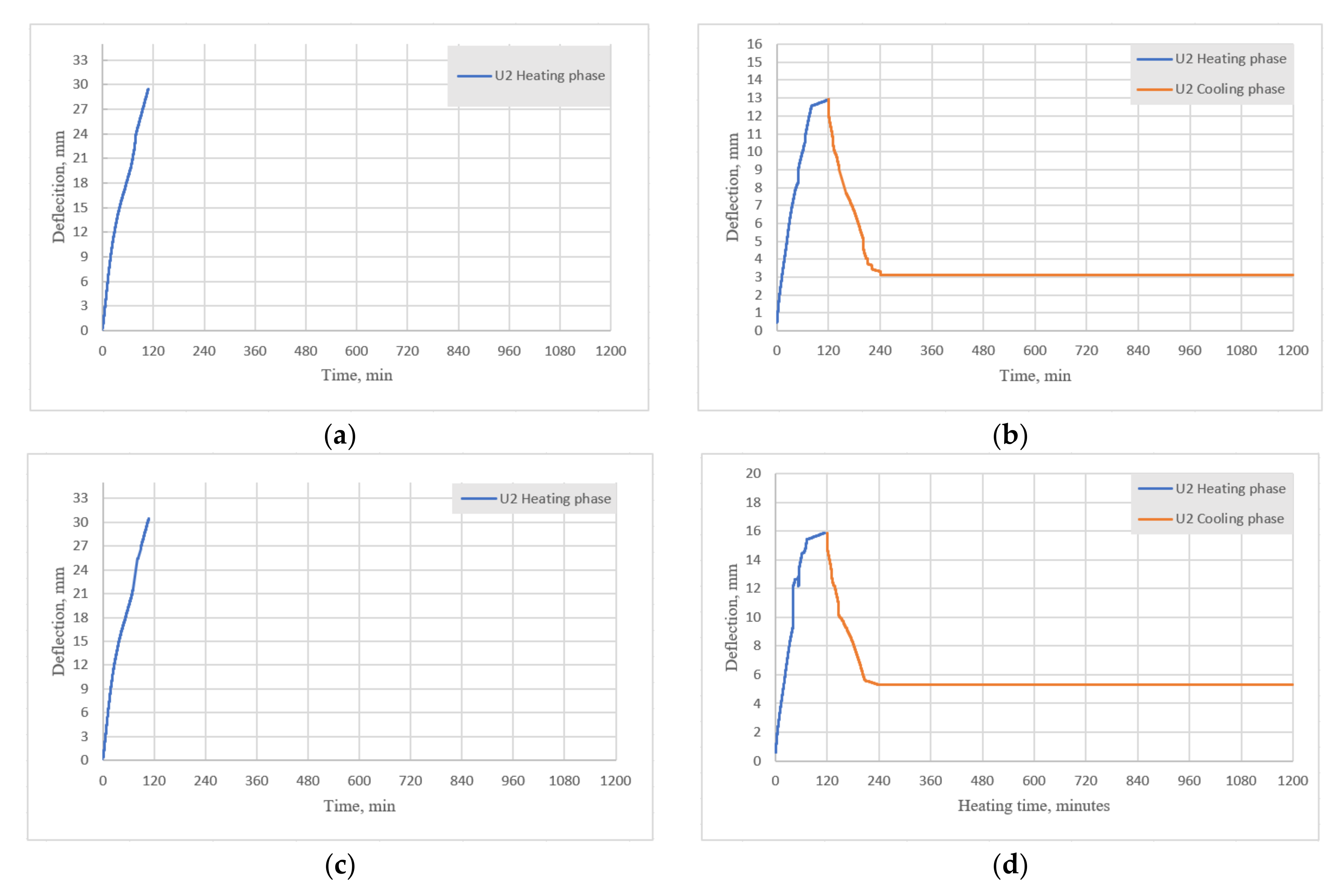
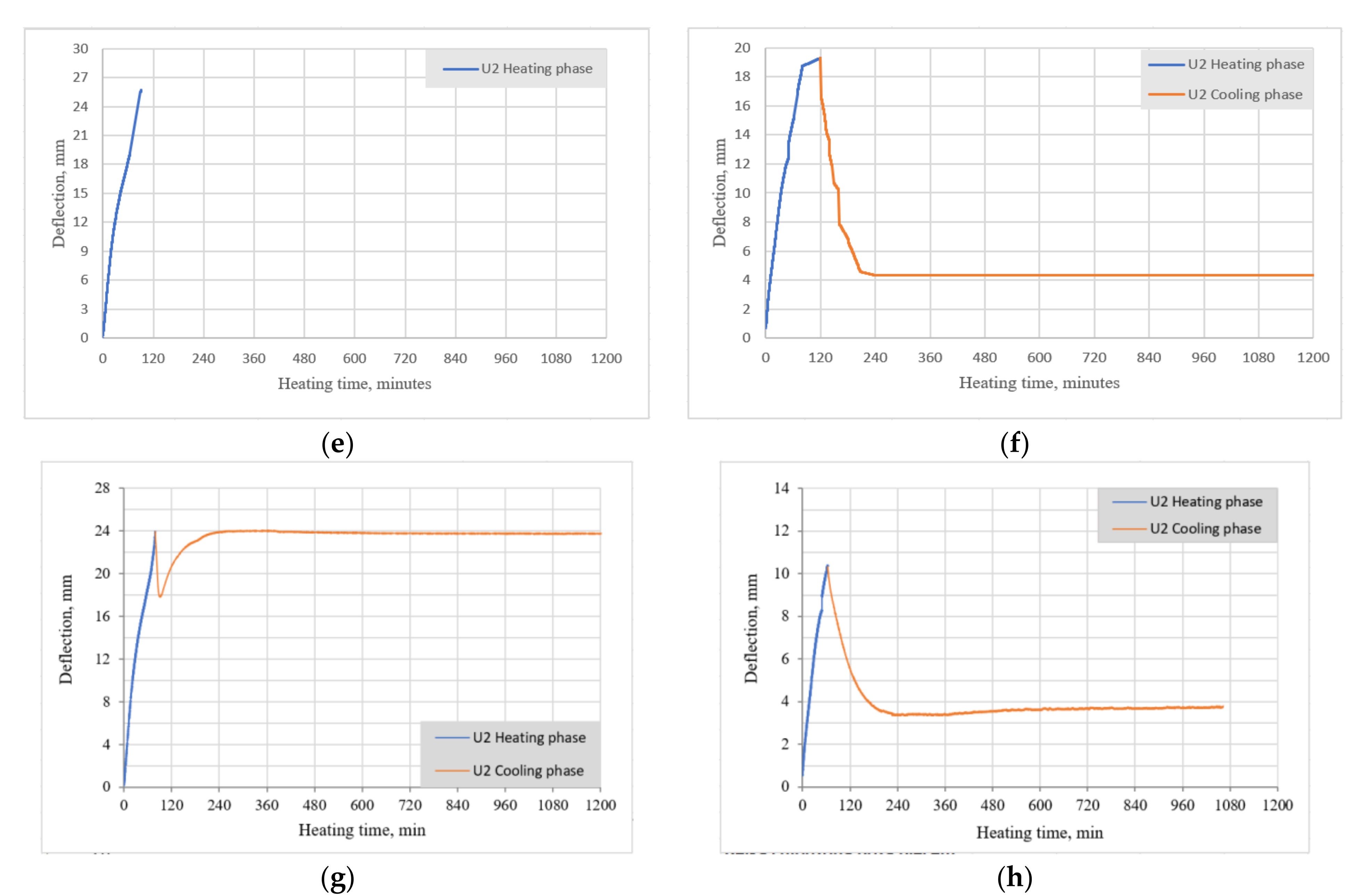
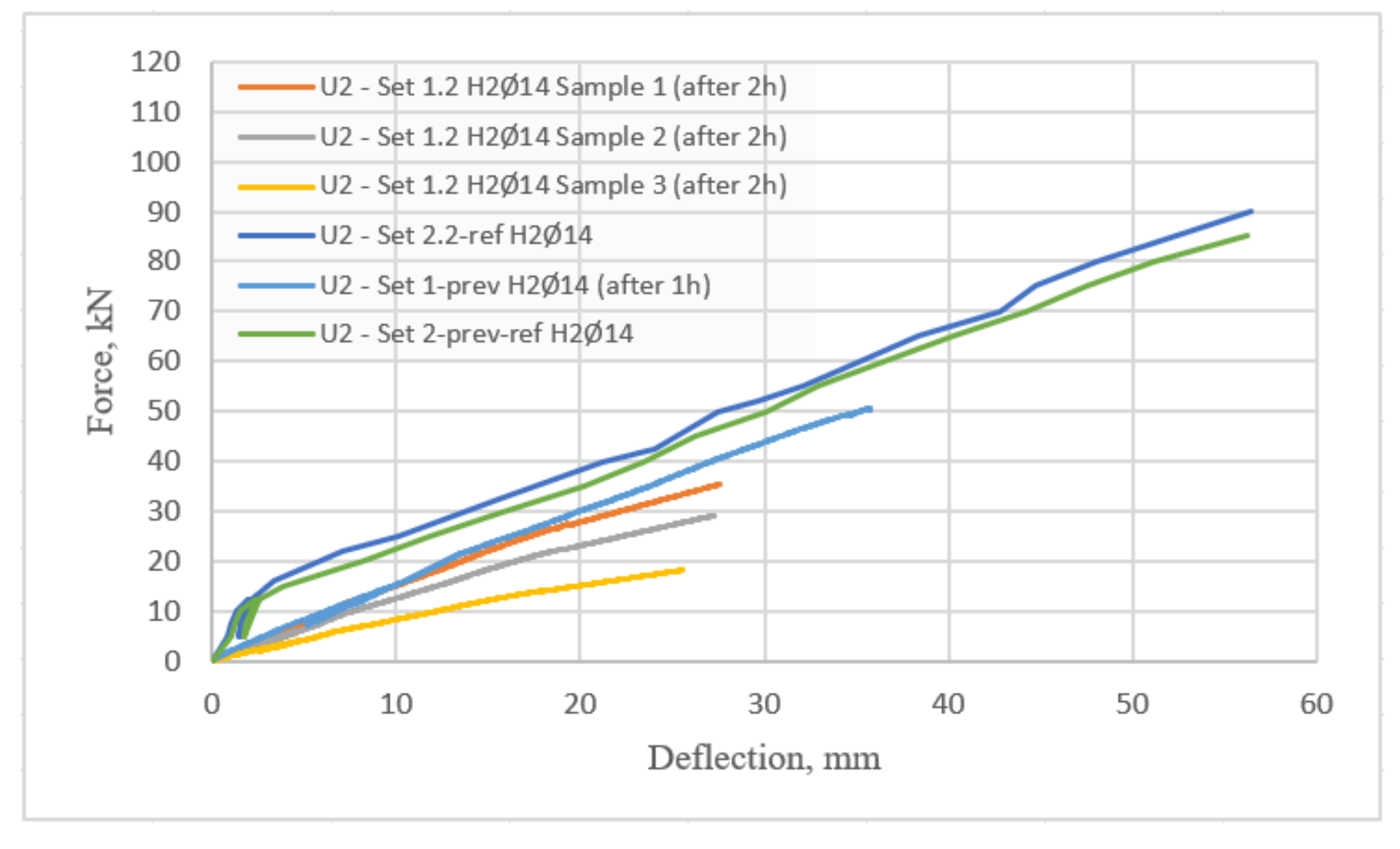
| Set No. | Description |
|---|---|
| 1.1 and 1.2 | In the present study, residual tests were conducted on these beams. |
| 2.1-ref and 2.2-ref | Those beams that were only subjected to flexural tests with four points, without preliminary loads, and that were not subjected to elevated temperatures. |
| 1-prev and 2-prev-ref | The results of that study were used primarily for comparison. Table 2 provides details about the specimens used in the previous study. |
| Set No. | Beam Designation | Dimensions of the Specimens | Concrete Cover | Number of Samples | Reinforcement Type (Tension Zone) | Preliminary Loaded (Approx. 50% of the Ultimate Load) |
|---|---|---|---|---|---|---|
| l/h/b 1 (mm) | (mm) | Number/Ø/Type | Yes/No (kN) | |||
| 1.1 | B2Ø14 | 3220/280/140 | 60 mm from bottom, 40 mm from other sides | 3 | 2/14/BFRP 2 | Yes (30) |
| 1.2 | H2Ø14 | 3 | 2/14/HFRP 3 | Yes (40) | ||
| 2.1-ref | B2Ø14 | 3 | 2/14/BFRP | No (0) | ||
| 2.2-ref | H2Ø14 | 3 | 2/14/HFRP | No (0) | ||
| 1-prev | B2Ø14 | 3200/260/140 | 30 mm from all sides | 1 | 2/14/BFRP | Yes (30) |
| H2Ø14 | 1 | 2/14/HFRP | Yes (40) | |||
| 2-prev-ref | B2Ø14 | 1 | 2/14/BFRP | No (0) | ||
| H2Ø14 | 1 | 2/14/HFRP | No (0) |
| Set No. | Period | Compressive Strength | Tensile Strength | Modulus of Elasticity |
|---|---|---|---|---|
| fc (MPa) | fct (MPa) | Ecm (GPa) | ||
| 1.1; 1.2; 2.1-ref; 2.2-ref | 28 days | 49.85 | 4.50 | 38.91 |
| 1-prev; 2-prev-ref | 48.75 | 4.23 | 37.83 |
| Type of Bars | Maximum Tensile Force | Tensile Strength | Tensile Strength at Rupture | Modulus of Elasticity |
|---|---|---|---|---|
| Type/Ø | Fu (kN) | fu (MPa) | εu (%) | E1 (GPa) |
| BFRP Ø6 | 37.07 | 1148.81 | 2.48 | 46.47 |
| BFRP Ø8 | 60.03 | 1103.30 | 2.52 | 43.87 |
| BFRP Ø14 | 179.26 | 1101.94 | 2.39 | 46.02 |
| HFRP Ø14 | 206.57 | 1160.06 | 1.61 | 72.12 |
Publisher’s Note: MDPI stays neutral with regard to jurisdictional claims in published maps and institutional affiliations. |
© 2022 by the author. Licensee MDPI, Basel, Switzerland. This article is an open access article distributed under the terms and conditions of the Creative Commons Attribution (CC BY) license (https://creativecommons.org/licenses/by/4.0/).
Share and Cite
Protchenko, K. Residual Fire Resistance Testing of Basalt- and Hybrid-FRP Reinforced Concrete Beams. Materials 2022, 15, 1509. https://doi.org/10.3390/ma15041509
Protchenko K. Residual Fire Resistance Testing of Basalt- and Hybrid-FRP Reinforced Concrete Beams. Materials. 2022; 15(4):1509. https://doi.org/10.3390/ma15041509
Chicago/Turabian StyleProtchenko, Kostiantyn. 2022. "Residual Fire Resistance Testing of Basalt- and Hybrid-FRP Reinforced Concrete Beams" Materials 15, no. 4: 1509. https://doi.org/10.3390/ma15041509
APA StyleProtchenko, K. (2022). Residual Fire Resistance Testing of Basalt- and Hybrid-FRP Reinforced Concrete Beams. Materials, 15(4), 1509. https://doi.org/10.3390/ma15041509






